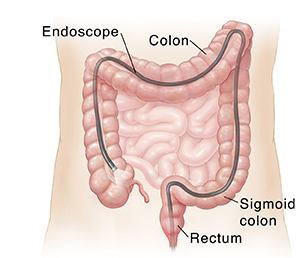Lower GI Endoscopy
Lower GI endoscopy lets your healthcare provider view your lower gastrointestinal (GI) tract. Your entire colon and rectum can be examined (colonoscopy). Or just the rectum and sigmoid colon can be examined (sigmoidoscopy).
 |
| During endoscopy, a long, flexible tube is used to view the inside of your lower GI tract. |
Before the exam
Follow these and any other instructions you are given before your endoscopy. If you don't follow the instructions for getting ready for this test, the test may need to be canceled or done again. For this reason, read your instructions carefully before the exam. Call your healthcare provider with any questions.
-
Follow any directions you're given for not eating or drinking before the test. For a colonoscopy, you may be told to eat and drink only clear liquids for 1 to 3 days before the exam. You may have other diet changes.
-
Take any laxatives that are prescribed for you. An enema may also be prescribed. Follow the instructions for these carefully.
-
Arrange for someone to drive you home after the exam if you'll be sedated.
-
Tell your healthcare provider about all the medicines you take. This includes any prescription or over-the-counter medicines. It also includes vitamins, herbs, and other supplements. Also tell the provider if you take any illegal drugs.
-
Tell your provider if you have any health problems or allergies.
-
Discuss possible alternatives to the procedure, and risks, with your healthcare provider.
The procedure
-
Colonoscopy can take 30 minutes or longer. Sigmoidoscopy often takes about 20 minutes or longer. The length of the procedure depends a lot on how clean your intestines are, the reason for the procedure, and what biopsies or treatments must be done.
-
You lie on the stretcher or bed on your left side.
-
For colonoscopy, you're given medicine to relax you (sedation). This is given through an IV (intravenous) line. You can choose not to get any sedation medicines. Discuss this with your provider. Sigmoidoscopy usually doesn’t need sedation.
-
The endoscope is inserted into your rectum. You may feel pressure and cramping. If you feel pain, tell your healthcare provider. You may get more sedation, which includes pain medicine and an anti-anxiety medicine.
-
The endoscope sends images of your colon to a video screen. Prints of the images may be taken as a record of your exam.
-
Biopsies (tissue samples), polyp removal, or other treatments may be done.
-
When the procedure is done, you rest for a time. You may have some discomfort right after the procedure from trapped air. This can be relieved by changing position and passing the air.
-
If you've been sedated, you must have an adult drive you home. Don't work, drive, or make big decisions for 24 hours after sedation.
When to call your healthcare provider
Call if your provider if you have any of the following after the procedure:
Call 911
Call 911, or get immediate medical care at the nearest emergency department , if you have heavy or prolonged rectal bleeding
Online Medical Reviewer:
Heather M Trevino BSN RNC
Online Medical Reviewer:
Robyn Zercher FNP
Online Medical Reviewer:
Ronald Karlin MD
Date Last Reviewed:
4/1/2024
© 2000-2024 The StayWell Company, LLC. All rights reserved. This information is not intended as a substitute for professional medical care. Always follow your healthcare professional's instructions.